Math Diagnostic Test For Students: Identify Learner Gaps And Guide Instruction
A math diagnostic test is designed to identify students’ misconceptions or knowledge gaps. They inform teachers’ decisions about the next stage of a lesson or programme of study.
Studies have shown that diagnostic tests are one of the top three most effective techniques to improve student achievement (Wisniewski, Zierer, and Hattie). But their effectiveness is dependent on how and when the test is delivered and how the results are used.
This guide will help you understand how to use math diagnostic tests in your school to improve student learning and students’ understanding.
Arithmetic Check for Understanding Quiz
10 questions with answers covering a range of 4th-6th grade topics, including number sense, word problems and order of operations, to identify areas of strength and where support is needed.
Download Free Now!What is a math diagnostic test?
A math diagnostic test is a form of pre-assessment that provides teachers with a detailed understanding of the individual student’s strengths and weaknesses. Made popular by Craig Barton, diagnostic tests provide a precise analysis of the misconception through each student’s chosen answer.
This type of assessment is most useful when focused on one subject knowledge area, for example, fractions, decimals or percentages. However, they can be used more broadly to identify mathematical gaps and misconceptions in students’ knowledge.
Diagnostic math tests are a type of formative assessment or assessment for learning. Unlike summative assessments, which measure learning and track progress, diagnostic assessment tools allow teachers to understand where knowledge gaps lie among students before, during or after a lesson.
The results of the math diagnostic test can be used to inform any targeted support or personalized intervention to improve a student’s academic achievement.
Structure and format of a math diagnostic test
Most often, math diagnostic tests are multiple choice questions set at the students’ grade level, appropriate for the student’s age and ability. A test should take no more than ten seconds for a student to complete, which means it can be used regularly by teachers throughout every lesson, providing frequent and detailed feedback from every single student.
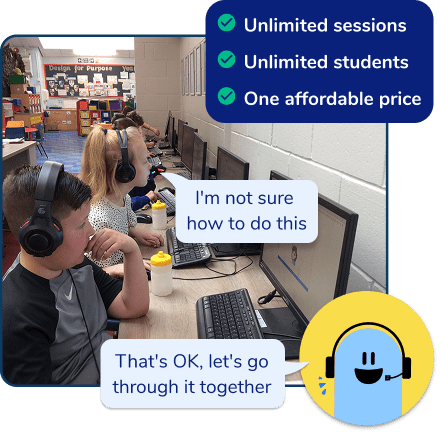
Meet Skye, the voice-based AI tutor making math success possible for every student.
Built by teachers and math experts, Skye uses the same pedagogy, curriculum and lesson structure as our traditional tutoring.
But, with more flexibility and a low cost, schools can scale online math tutoring to support every student who needs it.
Find out moreHow do math diagnostic tests improve learner outcomes?
Diagnostic assessments can help identify when an intervention is required and for which topics. However, students’ understanding and attainment only improve when teachers use the results effectively.
Diagnostic math tests provide teachers with valuable feedback about the effectiveness of their teaching methods and what learning has occurred. But crucially, the scores themselves are not the most important outcome. Errors offer significant value and actionable data. Well-designed diagnostic assessments should reveal detailed information about student understanding and learning gaps, such as:
Students’ misconceptions
Which students gave an incorrect answer
Why students made the mistake
This has a powerful impact on teachers’ ability to adjust the lesson and directly address students’ misconceptions to improve their learning and attainment. This key aspect is what differentiates diagnostic assessment from other assessments.
Students can also benefit from these results directly as they receive feedback on their understanding, allowing them to become more reflective and aware of their learning.
Use of diagnostic maths tests to improve student progress in tutoring
1. Design diagnostic questions that relate directly to instructional goals
When diagnostic questions are designed to relate directly to instructional goals, the resulting data becomes a powerful tool for improving student progress. This targeted approach avoids assessing irrelevant information and focuses the tutoring on the core learning objectives, resulting in more efficient use of time and resources.
Teachers using Third Space Learning math tutoring can use their diagnostic assessment data to select the standards and topics their students need additional support and practice during interventions. Alternatively, many schools send their assessment data to us and we select the best learning pathway for students. Our lessons are mapped to over 500+ Learning Objectives across all state standards in our online intervention curriculum.
2. Use diagnostic data to provide a benchmark
Initial diagnostic assessments help to measure student growth and the impact of tutoring across a semester.
3. Continuous assessment for learning within each lesson
Diagnostic math assessment should continue throughout an intervention period; not only at the start. This ensures tutoring is personalized. Tutors can differentiate instruction and pitch the content and pace appropriately to maximise student growth.
In Third Space Learning’s online one-on-one AI math tutoring, each student completes a diagnostic skill check in at the start of every online math lesson so Skye, Third Space’s voice-based AI expert math tutor, can assess their understanding of the math topic they will be working on. Skye then adapts the lesson based on the learner’s answer to provide them with the right level of support. If the student struggles or answers incorrectly, Skye walks them through the lesson step by step using the “I do, we do, you do” approach to scaffold learning. If the student answers correctly and shows readiness, Skye moves them straight to independent practice and more challenging questions. Skye uses formative assessment throughout the session to adapt learning and hints accordingly.
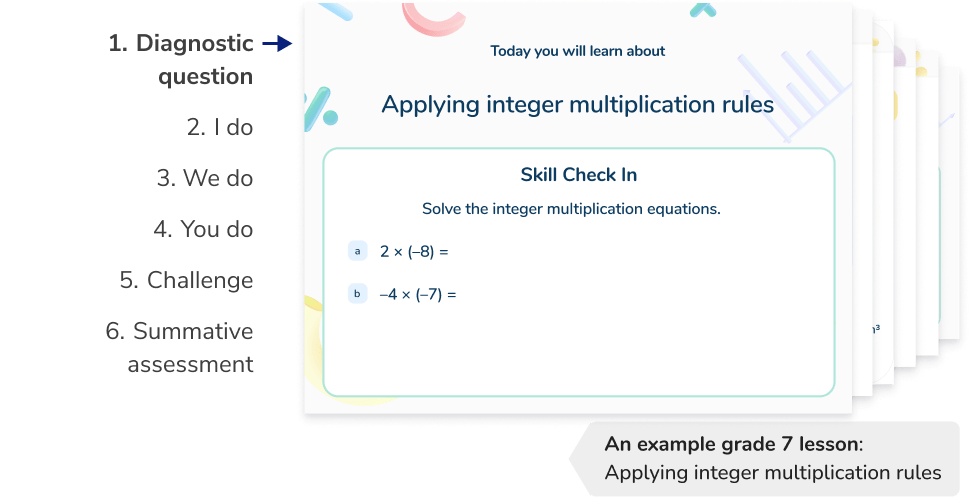
How to create an effective diagnostic math test for your own math lessons
There are three important areas for consideration when creating effective diagnostic tests for math lessons:
Effective design
Classroom culture
Professional development
1. Effective design of a diagnostic math test
The tests should be well-designed and tailored to the individual needs of the class.
Multiple choice questions are the most effective form of diagnostic math test with questions specifically designed to show any misconceptions. Each incorrect answer for the multiple choice question should relate to a different math misconception. It should not be possible for a student to select the correct answer while holding a misconception.
2. A low stakes environment with the freedom to make mistakes
Students will inevitably give incorrect answers so there needs to be a classroom culture that allows students to feel comfortable making mistakes. Incorrect answers represent an opportunity to improve – developing a growth mindset will be beneficial to learning.
It will be counterproductive if a diagnostic test creates anxiety. This adds to students’ cognitive load and makes it more difficult for them to learn new information. When teachers refer to incorrect answers as misconceptions, it can help lessen the anxiety or blame students feel.
During Third Space Learning online one-on-one math sessions, students are able to discuss, explain, and evaluate their thinking, as well as deepen their understanding in a nurturing low stakes environment. It’s one of the things the schools we work with love about our programs.
3. Professional development
The most experienced teachers will likely find it easier to identify the most common misconceptions associated with each topic. This knowledge makes it easier to set the questions for the assessment. This will typically develop naturally over time as a teacher’s experience grows but can be supported with resource sharing and professional development.
Sharing best practices is one of the most effective forms of teacher professional development. When it comes to diagnostic assessment, teachers can support colleagues by:
Sharing premade diagnostic questions
Sharing strategies and resources that challenge students’ misconceptions
Remember, it is not enough to identify students’ misconceptions. Teachers need to develop the skills required to challenge and correct them.
Free resources to make your own diagnostic math tests
Even the most experienced math teachers can find it time-consuming to create effective diagnostic math tests. That’s why Third Space Learning created a bank of free resources for teachers, suitable for students from 1st Grade to 8th grade.
Free multiple choice math tests aligned to your state standards
Misconceptions are a natural part of the learning process in mathematics. Identifying and challenging these misconceptions when they occur prevents them from becoming ingrained and detrimental to learning in the long run.
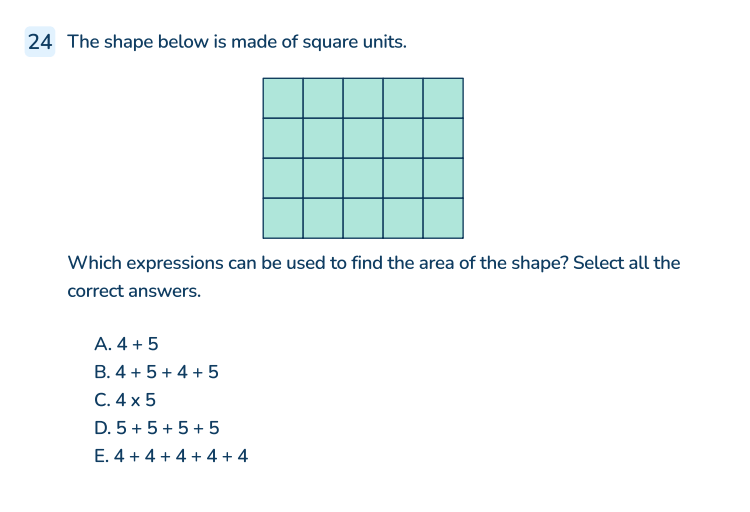
These free assessments from Third Space Learning are organised by grade level and are designed by experienced math teachers. They aim to provide a complete picture of student performance against national norms and each question and answer is mapped against its corresponding state standard. This supports teachers to identify areas of strength and weakness.
Using state tests as diagnostic assessment can also serve as preparation for students and help them to become accustomed to the style of questions they will be expected to answer.
Free check for understanding quizzes by topic
If you’re looking for something more topic specific for your class, there are also check for understanding quizzes. These retrieval quizzes are designed to provide an evaluation of students’ understanding and provide valuable data to teachers about student performance. These can be used before or at the beginning of instruction to assess any prerequisite skills or as a placement test. They can also be used during instruction as formative assessment or at the end of an instructional period or course.
These assessments cover a range of essential skills, including Number & Quantity, Algebra, Geometry, Measurement & Data, Statistics and Probability, Ratio and Proportion, and math problem-solving.
Do you have students who need extra support in math?
Skye—our AI math tutor built by experienced teachers—provides students with personalized one-on-one, spoken instruction that helps them master concepts, close skill gaps, and gain confidence.
Since 2013, we’ve delivered over 2 million hours of math lessons to more than 170,000 students, guiding them toward higher math achievement.
Discover how our AI math tutoring can boost student success, or see how our math programs can support your school’s goals:
– 3rd grade tutoring
– 4th grade tutoring
– 5th grade tutoring
– 6th grade tutoring
– 7th grade tutoring
– 8th grade tutoring
Diagnostic maths tests FAQs
A diagnostic maths test identifies students’ misconceptions to help adapt learning activities or instruction to meet students’ needs.
A multiple-choice diagnostic maths question has one correct answer that can only be answered correctly if a student does not hold any misconceptions. Each incorrect answer is designed to reveal a different misconception.
Formative assessments, such as diagnostic questions, are designed to improve learning. They provide educators with the necessary information to adapt their teaching. Summative assessments inform teachers about the learning students retain, such as an end-of-topic test.
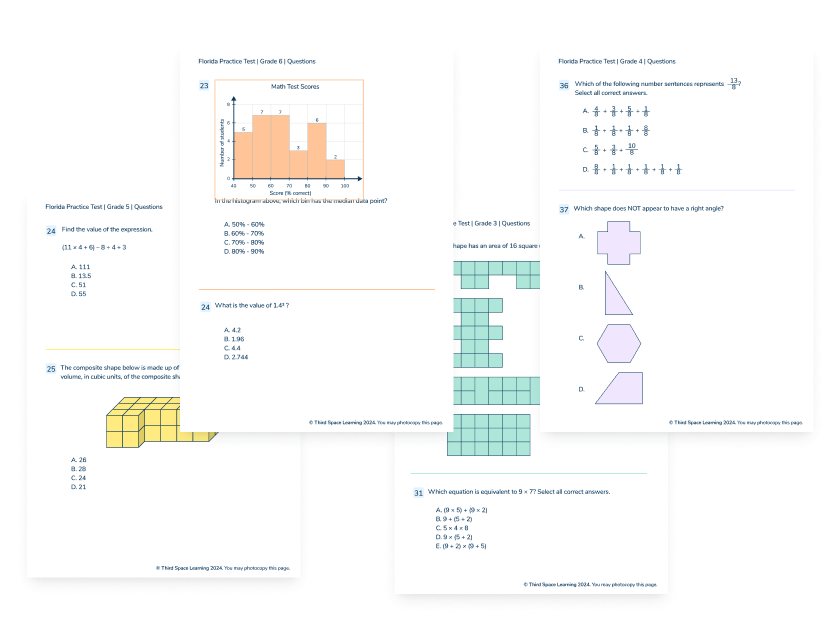

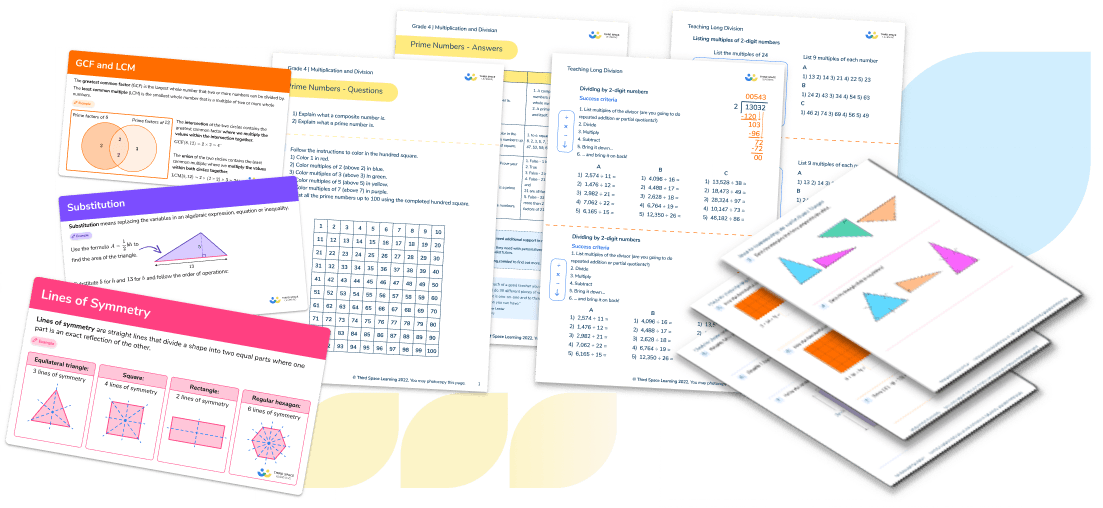
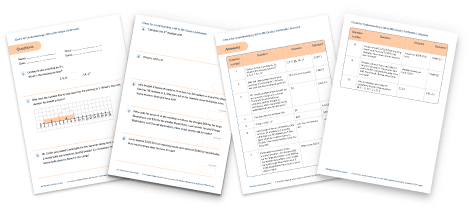



![Diagnostic Assessment: Your Teaching And Intervention Must Have [+ Free Resources]](https://thirdspacelearning.com/wp-content/uploads/2023/07/diagnostic-assessment-featured-image-180x160.jpg)